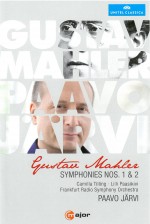 Mahler – Symphonies 1 & 2
Mahler – Symphonies 1 & 2
Camilla Tilling; Lilli Paasikivi; Frankfurt RSO; Paavo Järvi
Cmajor 718008
The genial Paavo Järvi, scion of his ubiquitous father Neeme’s musical clan, is evidently well-regarded in Frankfurt where he served as music director of the Frankfurt Radio Symphony Orchestra from 2002-2013. During his tenure there he presented a televised broadcast cycle of Mahler symphonies for Hessian Radio which is only now reaching these shores on the C major label. The First Symphony was filmed in the spa town of Wiesbaden in 2012. It is a curiously inconsistent performance, the highlight of which is a superbly paced third movement. I was quite taken aback to find Järvi’s take on the Scherzo movement stealing a move from the 2009 playbook of Gustavo Dudamel, namely broadening the first four bars of the bass ostinato in an oafish manner then gradually and elegantly leading into a lively dance tempo. Unlike Dudamel, in Järvi’s hands the gesture is merely clumsy and inconsistent. The grand finale is well enough done but suffers from incompetent video direction: a clear shot of the stunning coup de théâtre of all seven horns standing for the triumphant final peroration of the movement is totally missed! In sum this performance brings to mind the saying attributed to Samuel Johnson: “The part that is good is not original, and the part that is original is not good.”
The presentation of the Second Symphony fares far better. It was filmed at the former monastery of Kloster Eberbach over the course of two afternoons in June 2010. The extraneous studio lighting in daylight gives the unexceptional 720x480 video a decidedly washed-out look and the unfortunate Järvi sweats profusely, resembling an anxious Vladimir Putin caught under a searchlight. The performance of the first movement is solid though underwhelming, with Järvi applying an unusually broad tempo to the lyrical secondary theme and a rather too fast tempo in the coda. Matters improve considerably in the following movements, with a coyly fetching Menuetto and a Scherzo à la Bernstein being most impressive for the care taken to deal with the abbey’s long echoes. The penultimate “Urlicht” movement features the heartfelt mezzo solo of Lilli Paasikivi, who also excels in the subsequent movement. The performance catches fire in the Finale with an impressively frightening and tightly played “march of the dead” development section. Sadly, the combined NDR/Bavarian Radio choruses are set so far back in the apse of the cloister that their hushed entrance for the movement’s grand apotheosis is barely audible; furthermore the voice of the soprano soloist Camilla Tilling is intended to emerge imperceptibly from this choir but as she is placed far to the front of the orchestra the effect is ruined. Fortunately the dome above them serves as an effective resonator for the resounding passages later on. There is also an organ to be heard – though mysteriously unseen – in the closing pages. The DVD will certainly be of interest to Järvi fans and the orchestra is quite a fine one but the mundane television production values fail to approach the superb videos of Claudio Abbado from the Lucerne Festival.



